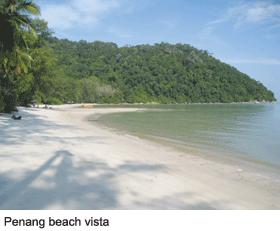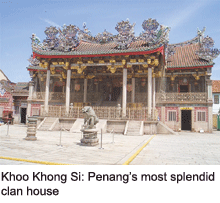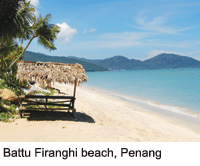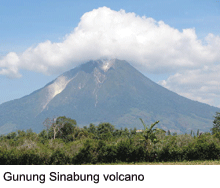Their growing sophistication, stylish resorts and spas offering ever smiling hospitality and superb service, have prompted a shift in Indian tourist traffic in favour of south-east Asian destinations. Yoginder Sikand took time off to visit some islands of Malaysia and Indonesia
 High prices and indifferent service — often tinged with racism — in Western countries which were hitherto the preferred destinations of the rising number of Indian tourists venturing abroad (16.3 million in 2008), have prompted a shift in favour of South-east Asian destinations. In particular, the newly resurgent countries of the near east — Thailand, Malaysia and Indonesia — all of which have developed excellent tourism infrastructure and are just a short three-four hour flight away (enabling substantial savings by way of air fares). Their growing sophisti-cation, stylish resorts and spas offering ever-smiling hospitality and superb deals, are reason enough for the fast-expanding Indian middle class which, recessionary winds notwithstanding, has the money and will to visit.
High prices and indifferent service — often tinged with racism — in Western countries which were hitherto the preferred destinations of the rising number of Indian tourists venturing abroad (16.3 million in 2008), have prompted a shift in favour of South-east Asian destinations. In particular, the newly resurgent countries of the near east — Thailand, Malaysia and Indonesia — all of which have developed excellent tourism infrastructure and are just a short three-four hour flight away (enabling substantial savings by way of air fares). Their growing sophisti-cation, stylish resorts and spas offering ever-smiling hospitality and superb deals, are reason enough for the fast-expanding Indian middle class which, recessionary winds notwithstanding, has the money and will to visit.
Of all the newly industrialised countries of South-east Asia, Malaysia has been wooing Indian tourists most assiduously. The slickly produced ‘Malaysia, Truly Asia’ ad campaign has been running on Indian cable television channels for several years and marvelously showcases the country’s tourist attractions, including Kuala Lumpur and the resort facilities of Penang and Langkawi. Therefore, when I was recently invited to participate in a fortnight-long workshop on ‘Religion and Modernity’ in Penang, I accepted with alacrity because it also offered me the opportunity to check out the insistently proclaimed charms of Penang and its contiguous areas.
One of the smallest states of Malaysia, Penang is a melting-pot of various cultures, but has a distinct colonial flavour. Bounded on all sides by the Straits of Malacca, it’s a four-hour drive from Kuala Lumpur to Georgetown (pop. 400,000), the island’s major settlement. This was where our workshop was being held, and so every afternoon I would slip out to do a bit of exploring on my own. The best way to do that, I discovered, was on foot, for its vibrant street life is one of Penang’s major draws.
Slipping under rows of globular paper lanterns, decorated with quaint Chinese pictograms, and gigantic boards painted with flame-spouting dragons, I entered China Town, the atmospheric hub of Georgetown. This area of the city was built some 300 years ago to house Chinese labour and traders, whose descendants today constitute the majority of Penang (800,000). Rows of narrow streets crisscross each other, lined with double-storey Chinese-style cottages which serve both as homes and shops. Votive platforms and grave-faced ancestral deities perched on winged horses guard each home, keeping evil spirits away.
Penang’s sizeable Chinese community proudly traces its ancestry to several regions of southern China. Each clan maintains a separate clan-house or khong si, with a temple dedicated to its ancestors. These are sprawling complexes that are in effect private clubs where members socialise, propitiate their deities and ancestors, transact business with clansmen and resolve intra-clan disputes.
 The Khoo Khong Si upon which I had providentially stumbled, is Penang’s most splendid clan-house. Constructed entirely of wood and richly decorated with Chinese landscape paintings, the clan-house is a unique work of art. Statues of wizened ancestors squat on gilded thrones, presiding over enormous copper jars and porcelain urns filled with fruits and massive joss-sticks offered by devotees. Clay ovens throw up clouds of sweet-smelling smoke as they consume vast quantities of paper objects, including letters whose messages are believed to be transferred to long-deceased ancestors. Stalls outside the temple do brisk business selling wads of mock paper money (issued by ‘The Bank of Hell’ or the ‘Bank of Heaven’), apparel, designer shoes and lacy underwear, tubes of toothpaste, packets of biscuits and even mobile phones and pocket transistors, all made of paper but which, from a distance, look very real, and are duly offered to ancestors.
The Khoo Khong Si upon which I had providentially stumbled, is Penang’s most splendid clan-house. Constructed entirely of wood and richly decorated with Chinese landscape paintings, the clan-house is a unique work of art. Statues of wizened ancestors squat on gilded thrones, presiding over enormous copper jars and porcelain urns filled with fruits and massive joss-sticks offered by devotees. Clay ovens throw up clouds of sweet-smelling smoke as they consume vast quantities of paper objects, including letters whose messages are believed to be transferred to long-deceased ancestors. Stalls outside the temple do brisk business selling wads of mock paper money (issued by ‘The Bank of Hell’ or the ‘Bank of Heaven’), apparel, designer shoes and lacy underwear, tubes of toothpaste, packets of biscuits and even mobile phones and pocket transistors, all made of paper but which, from a distance, look very real, and are duly offered to ancestors.
Under British rule, Georgetown served as the administrative centre of Penang. Today, the town’s imposing colonial-period government offices have been converted into banks, hotels, museums, boutiques, municipal offices, and mostly into eateries, for eating seems to be the island’s favourite past-time. I did a quick round of China Town’s restaurants, mostly Chinese but some Malay as well. Unfortunately, as a fussy vegetarian, I couldn’t sample any of the exotic fare on offer, which included skinned frogs, boiled squid, octopus soup, baked duck, quail eggs boiled in tea and stir-fried snails. Vegetarian food, I was informed, could only be found in the ‘Little India’ part of Georgetown.
For Indian visitors, one of Malaysia’s greatest blessings is its sizeable (approx. 2 million) ethnic Indian population, which means that Indian food is readily available and one never really feels out of place anywhere in the country. Following the advice I received from friendly restaurateurs, I made for Little India and was greeted by a neatly whitewashed domed structure, purported to be a replica of a well-known dargah of a Sufi saint in Tamil Nadu. It stood cheek by jowl with a sprawling south Indian Hindu temple, from whose dark inner chambers, muffled clanks of bells and booms of gongs could be heard.
An astrologer clad in an ochre robe, ash smeared across his forehead, squatted on the pavement, surrounded by a waiting ring of clients. Wheel-cart vendors sold bunches of fresh sweet-smelling flowers, banana chips, framed pictures of Hindu deities, and CDs of the latest Bollywood and Tamil films. A row of restaurants serving Indian food lined an entire street. Brightly lit shops stocked sarees, lungis, Bollywood-style blouses, gold jewellery, incense and spices — all imported from India. I had solved my culinary problem and felt miraculously transported back home.
Chinese communities are scattered across Penang, and one of these, not far from Little India, is built around a unique temple, the She Miao, which roughly translates as ‘The Shrine of the Azure Cloud’. Not as benign as its quaint name might sound, its major attraction is the dozens of poisonous vipers and deadly cobras that it houses.
 The workshop I was attending soon proved to be too tedious to tolerate and craving adventure, I managed to slip out regularly without being noticed, to explore the less touristy parts of Penang beyond Georgetown. The Battu Firanghi beach is touted in brochures as one the finest stretches of sand and glistening blue sea in all of Malaysia, but I found it grossly over-developed. As elsewhere in Penang, high-rise apartment buildings, shopping malls and luxury hotels have sprung up in Battu Firanghi as well.
The workshop I was attending soon proved to be too tedious to tolerate and craving adventure, I managed to slip out regularly without being noticed, to explore the less touristy parts of Penang beyond Georgetown. The Battu Firanghi beach is touted in brochures as one the finest stretches of sand and glistening blue sea in all of Malaysia, but I found it grossly over-developed. As elsewhere in Penang, high-rise apartment buildings, shopping malls and luxury hotels have sprung up in Battu Firanghi as well.
Therefore I headed for Taman Negara, a virgin tropical jungle on the northern tip of the island featuring mountains that gently slope into the sea. I was fortunate to spot some rare insect species — spiders as large as birds, stick insects that cleverly disguise themselves as thin branches, and leaf insects that are mistaken by their hapless prey for decaying leaves. Unfortunately, I failed to spot the giant Sumatra hornbill, said to abound in these parts. But I did see this marvellous avian specimen and several other exotic species in Malaysia’s finest bird park in Butterworth, a township on the other side of the narrow channel that divides Penang from the Malaysian mainland.
After being pampered for a fortnight at the fancy hotel where the workshop was being held, I wanted to venture out on my own. So I bought a ticket on a ferry headed from Penang to Medan, a city on the Indonesian island of Sumatra, one of the largest islands of the world. I was warned that, compared to Malaysia, neighbouring Indonesia was much poorer and more chaotic. But I was also told that for travelers with a taste for adventure it was far more exciting.
 The six-hour journey across the choppy Andaman Sea, my first experience of long-distance sea travel, proved to be a horror story, but the kind of unscripted adventure a traveler secretly yearns for. We sailed past several small uninhabited islands, hidden under a profusion of tropical jungle and ringed with sparkling white beaches. An hour later, we were in the open sea. Suddenly, the sky turned dark grey. Thunder rolled and menacing bolts of lightning flashed across the late afternoon sky. Gusty winds howled, heralding the arrival of a fierce tropical storm. Our ferry, a diminutive Indonesian craft, heaved violently and bounced through huge water valleys and mountains. Panic-stricken passengers screeched in terror as enormous water waves swept over the windows of the ferry to crash on the deck above. Miraculously we didn’t lose course, and the ferry steered its way to the port of Belawan in Sumatra, two hours behind schedule.
The six-hour journey across the choppy Andaman Sea, my first experience of long-distance sea travel, proved to be a horror story, but the kind of unscripted adventure a traveler secretly yearns for. We sailed past several small uninhabited islands, hidden under a profusion of tropical jungle and ringed with sparkling white beaches. An hour later, we were in the open sea. Suddenly, the sky turned dark grey. Thunder rolled and menacing bolts of lightning flashed across the late afternoon sky. Gusty winds howled, heralding the arrival of a fierce tropical storm. Our ferry, a diminutive Indonesian craft, heaved violently and bounced through huge water valleys and mountains. Panic-stricken passengers screeched in terror as enormous water waves swept over the windows of the ferry to crash on the deck above. Miraculously we didn’t lose course, and the ferry steered its way to the port of Belawan in Sumatra, two hours behind schedule.
A horde of aggressive men pretending to be helpful pushed and shoved at the exit of the ferry station, waiting to pounce on unsuspecting travelers. I had been warned that visitors to Indonesia must be wary of them, so I ignored their blandishments and plunged into an over-crowded bus heading for Medan.
Medan (pop. 3 million) is a large, hot, crowded and chaotic city. Under the Dutch it was a centre of the tobacco trade. Now, it shows every sign of irreversible decay. There is little to see in the town, which visitors to Sumatra use only as a base for excursions further into the island. But, after the harrowing experience of the ferry, I felt the need to relax for a day. I took a room in a lodge adjacent to the magnificent Masjid Rakyat, the town’s principal mosque, which after being redesigned by a Dutch architect, resembles a Christian cathedral featuring stunning stained glass windows.
 The next morning, I was woken by the mellifluous sound of a muezzein’s call to prayer wafting from the mosque. I walked around the Masjid Rakyat and into the neglected cemetery behind it, which hosts the graves of the kings of the Sultanate of Deli, of which Medan was the capital until the Dutch captured Sumatra in late 17th century. Known as rajas, although they were Muslims, the Deli rulers retained many of the Indic traditions that had struck root in the island following a long Hindu presence dating back to 200 B.C. The rulers of Deli were believed to be of Indian origin — Tamil say some, Gujaratis opine others, Oriyas insist yet others. They styled themselves rajas, and their prime ministers as perdan mentari, a corruption of the Sanskrit pradhan mantri. Inscriptions on the gravestones of the rajas and perdan mentaris of the Deli dynasty depict distinctively Indic words — the most common being parameswara and sri prakasa — which are appended to Arabic names, indicating a near-forgotten Hindu-Muslim syncretistic tradition.
The next morning, I was woken by the mellifluous sound of a muezzein’s call to prayer wafting from the mosque. I walked around the Masjid Rakyat and into the neglected cemetery behind it, which hosts the graves of the kings of the Sultanate of Deli, of which Medan was the capital until the Dutch captured Sumatra in late 17th century. Known as rajas, although they were Muslims, the Deli rulers retained many of the Indic traditions that had struck root in the island following a long Hindu presence dating back to 200 B.C. The rulers of Deli were believed to be of Indian origin — Tamil say some, Gujaratis opine others, Oriyas insist yet others. They styled themselves rajas, and their prime ministers as perdan mentari, a corruption of the Sanskrit pradhan mantri. Inscriptions on the gravestones of the rajas and perdan mentaris of the Deli dynasty depict distinctively Indic words — the most common being parameswara and sri prakasa — which are appended to Arabic names, indicating a near-forgotten Hindu-Muslim syncretistic tradition.
Just across from the mosque was the Istanta Maimoona — a modestly-sized palace of the Rajas of Deli. I walked the extensive grounds surrounding the palace, now overgrown with tangled weed.
One section of the palace is open to the public, with the rest still occupied by the descendants of the last sultan. The half-dozen rooms that are open to visitors display the usual royal knick-knacks — silken gowns, faded pictures of the rajas and their consorts clad in turbans and flowing gowns, an enormous gilded bed and carved ivory bowls. For a hefty fee I donned the last sultan’s robes and sat on his throne, a creaky wooden chair, and was photographed in borrowed royal plumes.
But now, the descendants of the Deli royal family seem to have fallen on hard times. Some of them run a beauty salon behind the palace; others eke out a living selling ice cream and fruits in makeshift stalls just outside the palace, and yet others solicit alms. Neglected mounds of garbage accumulate in the vicinity of the royal chambers, testimony to the drastically changed fortunes of the erstwhile Rajas of Medan.
With the heat, humidity and chaos of the city proving unbearable, I boarded a country bus and wound my way up to Berastagi, a town set in the lap of a range of towering volcanoes. Pulling out of the smoke-choked streets of Medan, the bus rushed through flat paddy fields ringed with banana, coconut and arecanut plantations, before ascending into thickly-forested mountains. Suma-tra straddles the equator, and perennial rainfall through the year stimulates thick vegetation. Until recently all of Sumatra was under dense forest cover, and although logging continues unchecked, large parts of the island are still covered with impenetrable tropical jungle.
Berastagi (pop.100,000) is a mere two-hour drive from the blisteringly hot and humid plains of Medan, but since we had climbed high up into the mountains, the air was crisp and cool. The town would have been even more endearing if its denizens and the local authorities had paid at least some attention to public hygiene which Berastagi, like most of the rest of Sumatra, sorely lacks. But that was more than compensated for by the cheery room in a family-run lodge into which I checked in. With its own private garden comprising orchids, strawberries and a tiny pond filled with tropical fish — all for the equivalent of less than Rs.300 — I felt it was worth escaping the madding chaos of Medan.
 Berastagi is one of Sumatra’s most popular hill stations. Most visitors come to climb the volcanic peaks ringing the town. I trekked to the base of the Gunung Sibayak, a dormant volcano (2,172 metres) which looms over the town. En route, I passed through a short stretch of forest replete with a variety of brilliantly-hued orchids. Huge butterflies, in a range of electric hues, dipped in and out of thick clumps of bamboo growing in rain-fed pools. I’d heard dragon tales about mammoth mammals lurking in the forest, but all I saw were a family of blue-striped giant monitor lizards, the size of baby dinosaurs.
Berastagi is one of Sumatra’s most popular hill stations. Most visitors come to climb the volcanic peaks ringing the town. I trekked to the base of the Gunung Sibayak, a dormant volcano (2,172 metres) which looms over the town. En route, I passed through a short stretch of forest replete with a variety of brilliantly-hued orchids. Huge butterflies, in a range of electric hues, dipped in and out of thick clumps of bamboo growing in rain-fed pools. I’d heard dragon tales about mammoth mammals lurking in the forest, but all I saw were a family of blue-striped giant monitor lizards, the size of baby dinosaurs.
As I neared the rim of the volcano, a powerful stench of sulfur gas, like rotten eggs, filled the air. Huge clouds of smoke swirled out of rock crevices of the massive crater. Furious hot blasts emanating from the volcano dissuaded me from getting right to the rim of the crater.
Instead, I undertook a trek to another major volcano — the Gunung Sinabung (2,417 metres). It was relatively easy going. Vans traverse the 30 km distance from Berastagi to the massive Lake Karwar, at the foot of the volcano. But the excursion, I discovered, required considerable resources of courage and fortitude. The route’s numerous hairpin bends were negotiated at reckless speed, and there were dozens of stops on the way, with the van picking up villagers transporting farm produce to nearby market towns. The goat that I was forced to share a seat with was quite civil as goats go, but obviously innocent of bathing practices.
 Yet the ride was well worth the effort, for the brilliant countryside dominated by the nominally Christian Batak Karo tribe, is the horticulture basket of Sumatra. Wooded hills and narrow valleys, dotted with thatched roofs of homes on stilts gazing over paddy and strawberry fields as also apple, coffee and cocoa plantations were sheer eye candy. The bus ride terminated on the banks of Lake Karwar, where fishing craft made of bamboo strapped together with rope, bobbed gently on the lake’s still waters. From there one could view the awesome summit of Gunung Sinabung, shrouded in a thick blanket of clouds — a picture of perfect placidity.
Yet the ride was well worth the effort, for the brilliant countryside dominated by the nominally Christian Batak Karo tribe, is the horticulture basket of Sumatra. Wooded hills and narrow valleys, dotted with thatched roofs of homes on stilts gazing over paddy and strawberry fields as also apple, coffee and cocoa plantations were sheer eye candy. The bus ride terminated on the banks of Lake Karwar, where fishing craft made of bamboo strapped together with rope, bobbed gently on the lake’s still waters. From there one could view the awesome summit of Gunung Sinabung, shrouded in a thick blanket of clouds — a picture of perfect placidity.
Although the rustic charm of Gunung Sinabung merited at least a week to savour fully, I had to move on. There was much more to explore in Sumatra, the largest of Indonesia’s 17,000 islands, and home to literally dozens of tribes and ethnic groups. After three days tramping up and down volcano slopes, I decided to travel further inland, to the land of the Batak Toba tribe. And so, after changing three buses and two boats, I reached a tiny settlement bearing the droll name of Tuk-Tuk. It was a good decision. I had arrived at one of the most visually stunning places I have ever visited. But, more about Tuk-Tuk in the next edition of this travelogue .